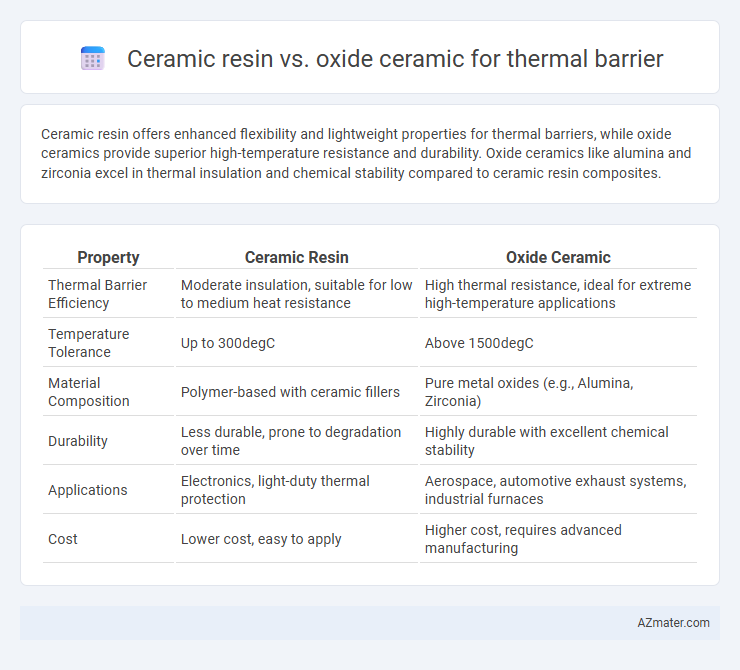Ceramic resin offers enhanced flexibility and lightweight properties for thermal barriers, while oxide ceramics provide superior high-temperature resistance and durability. Oxide ceramics like alumina and zirconia excel in thermal insulation and chemical stability compared to ceramic resin composites.
Table of Comparison
| Property | Ceramic Resin | Oxide Ceramic |
|---|---|---|
| Thermal Barrier Efficiency | Moderate insulation, suitable for low to medium heat resistance | High thermal resistance, ideal for extreme high-temperature applications |
| Temperature Tolerance | Up to 300degC | Above 1500degC |
| Material Composition | Polymer-based with ceramic fillers | Pure metal oxides (e.g., Alumina, Zirconia) |
| Durability | Less durable, prone to degradation over time | Highly durable with excellent chemical stability |
| Applications | Electronics, light-duty thermal protection | Aerospace, automotive exhaust systems, industrial furnaces |
| Cost | Lower cost, easy to apply | Higher cost, requires advanced manufacturing |
Introduction to Thermal Barrier Materials
Thermal barrier materials are essential for protecting components from extreme heat, with ceramic resin and oxide ceramics being two primary types. Ceramic resins offer flexibility and lightweight properties ideal for intricate shapes, while oxide ceramics, such as zirconia, provide superior thermal insulation and high-temperature stability. Choosing between ceramic resin and oxide ceramic depends on application-specific thermal conductivity, durability, and environmental resistance requirements.
Overview of Ceramic Resins
Ceramic resins are advanced polymer matrices infused with ceramic fillers, providing excellent thermal insulation and stability for thermal barrier coatings compared to oxide ceramics. These resins exhibit superior adhesion, flexibility, and resistance to thermal shock, making them ideal for complex geometries and dynamic thermal environments. Unlike rigid oxide ceramics, ceramic resins enable lightweight, durable, and cost-effective thermal protection solutions in aerospace, automotive, and energy applications.
Understanding Oxide Ceramics
Oxide ceramics offer superior thermal stability and corrosion resistance compared to ceramic resins, making them ideal for thermal barrier coatings in high-temperature environments. Their crystalline structure enables low thermal conductivity and excellent mechanical strength at elevated temperatures, crucial for protecting turbine blades and engine components. Unlike ceramic resins, oxide ceramics such as zirconia and alumina maintain performance under thermal cycling and oxidative conditions, enhancing durability and efficiency in aerospace and industrial applications.
Key Properties of Ceramic Resin Barriers
Ceramic resin thermal barriers offer superior flexibility and ease of application compared to oxide ceramics, with high thermal stability and excellent adhesion to various substrates. These barriers demonstrate low thermal conductivity and enhanced resistance to thermal shock, making them ideal for protecting components exposed to rapid temperature fluctuations. Their lightweight nature and chemical inertness contribute to long-term durability in harsh environments where oxide ceramic barriers might suffer from brittleness and cracking.
Key Properties of Oxide Ceramic Barriers
Oxide ceramic thermal barriers, such as yttria-stabilized zirconia (YSZ), exhibit superior thermal insulation due to low thermal conductivity and high melting points above 2700degC, outperforming ceramic resins. These barriers provide exceptional thermal shock resistance and chemical stability in oxidizing environments, critical for aerospace and industrial turbine applications. Their microstructure, often consisting of fine-grained, porous compositions, enhances heat dissipation while maintaining mechanical strength under extreme thermal cycling.
Thermal Insulation Performance Comparison
Ceramic resin exhibits lower thermal conductivity, typically around 0.2 to 0.5 W/m*K, making it effective for thermal insulation applications in moderate temperature ranges up to 600degC. Oxide ceramics such as zirconia and alumina offer superior thermal barrier performance with thermal conductivities below 2 W/m*K and high thermal stability above 1000degC, crucial for advanced thermal barrier coatings (TBCs) in aerospace and automotive industries. The choice between ceramic resin and oxide ceramic depends on the operating temperature requirements and thermal insulation efficiency needed for specific high-temperature environments.
Mechanical Strength and Durability
Ceramic resin thermal barriers exhibit high mechanical strength due to their polymer matrix, offering excellent impact resistance and flexibility under thermal cycling, which enhances durability in fluctuating temperatures. Oxide ceramics, such as zirconia and alumina, provide superior hardness and wear resistance with exceptional thermal stability, maintaining integrity at higher temperatures but with increased brittleness compared to ceramic resin composites. Durability in oxide ceramics favors long-term high-temperature applications, while ceramic resin thermal barriers are preferred for components requiring mechanical toughness alongside thermal protection.
Application Suitability and Industry Use
Ceramic resin materials offer superior flexibility and ease of application, making them ideal for complex geometries in aerospace thermal barrier coatings where lightweight protection is critical. Oxide ceramics, such as yttria-stabilized zirconia (YSZ), provide exceptional thermal resistance and structural stability at high temperatures, widely used in gas turbines and automotive exhaust systems. The choice between ceramic resin and oxide ceramic depends on the specific operational temperature range and mechanical stress requirements in industries like aerospace, power generation, and automotive manufacturing.
Cost and Manufacturing Considerations
Ceramic resin materials generally offer lower manufacturing costs and simpler processing techniques compared to oxide ceramics, making them advantageous for cost-sensitive thermal barrier applications. Oxide ceramics, such as zirconia-based coatings, provide superior thermal resistance and durability but require more complex, energy-intensive fabrication processes that increase overall expenses. Choosing between ceramic resin and oxide ceramic depends on balancing initial production costs against long-term performance requirements in high-temperature environments.
Future Trends in Thermal Barrier Technologies
Ceramic resin and oxide ceramic materials play pivotal roles in advancing thermal barrier technologies, with ceramic resins offering enhanced flexibility and lightweight properties for aerospace and automotive applications. Oxide ceramics, particularly yttria-stabilized zirconia (YSZ), continue to dominate due to their exceptional thermal stability and resistance to high-temperature oxidation. Future trends emphasize the development of nanostructured ceramic composites and hybrid coatings to achieve superior thermal insulation, durability, and environmental resistance for next-generation engine components and energy systems.

Infographic: Ceramic resin vs Oxide ceramic for Thermal barrier
 azmater.com
azmater.com